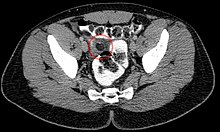Appendix epiploica
Appendices epiploicae (singular appendix epiploica , from Latin appendix 'appendix' and Greek ἐπίπλοον epiploon ' network ') are 1–4 cm long, free-ending processes along the Taenia libera and Taenia omentalis of the colon ( ascending colon , transversum , descending , sigmoideum ) . These are fatty tissue deposits covered by serosa . They maintain the capillarity of the abdominal cavity gap during the movement of the bulges of the large intestinal wall (house doors ).
The Appendices epiploicae were first described by Andreas Vesalius .

In rare cases these appendages can be twisted (torsion) and infarcted , which is then painful and, depending on the location of the appendix affected , can be mistaken for normal appendicitis or sigmoid diverticulitis . One then speaks of epiploic appendicitis . In the English language is also used by a epiploic appendagitis spoken to confusion with appendicitis the appendix to avoid.
Web links
- Michael Sand et al. a .: Epiploic appendagitis - clinical characteristics of an uncommon surgical diagnosis (PDF; 520 kB) BMC Surgery 2007, 7:11 (1 July 2007)
Individual evidence
- ↑ Walther Graumann: Compact Textbook Anatomy 3 . Schattauer Verlag 2004 ISBN 978-3-7945-2063-3 , p. 110.
- ↑ Case description in the Swiss Medical Forum No. 43 October 22, 2003 (PDF; 83 kB).
- ↑ For example, AK Singh et al. CT Appearance of Acute Appendagitis. AJR 2004; 183: 1303-1307 .
